MARIANI’S
Virtual
Gourmet
August 13, 2017
NEWSLETTER

Bird's Custard ad, circa 1928
IN THIS ISSUE
By John A. Curtas
FLAMBOYANT FAN OF LA NOUVELLE CUISINE
CHRISTIAN MILLAU DIES AT 88
BY John Mariani
NEW YORK CORNER
IMLI
By John Mariani
NOTES FROM THE WINE CELLAR
WHAT I'M DRINKING NOW
By John Mariani
❖❖❖
ON THE TEXAS BBQ TRAIL
Part One
By John A. Curtas
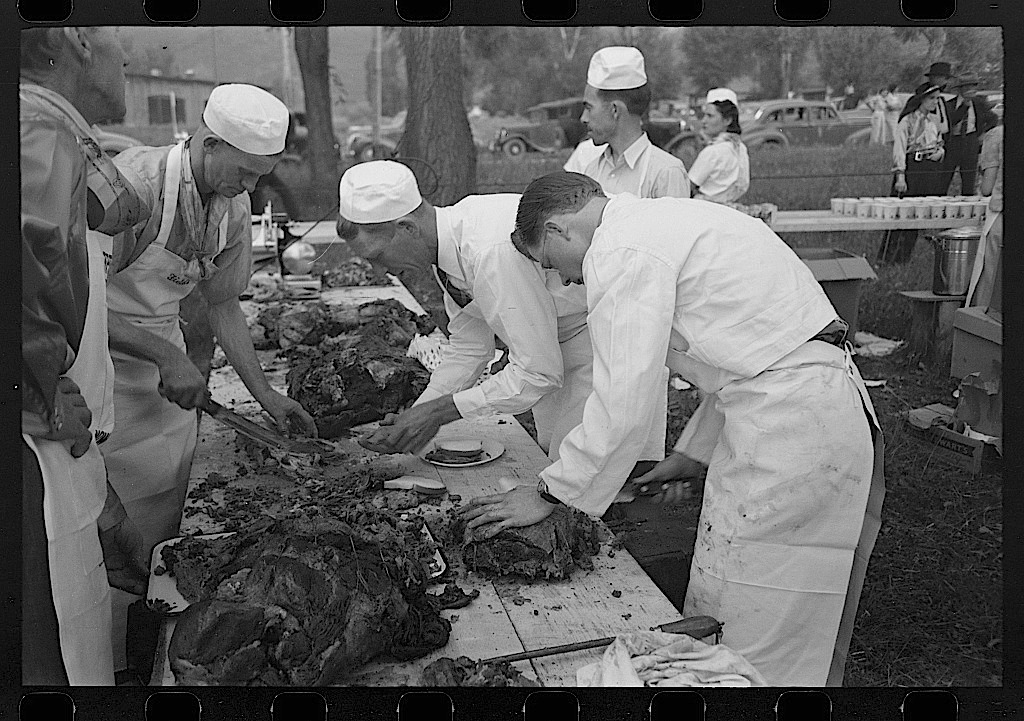
Photo by Lee Russell (1940) from Library of Congress
Back
in the day, you went barbecue hunting with
only your nose as a guide. If you were
lucky, you had  an
address or a scrap of newspaper (or a
weather-beaten magazine article) in your
pocket, and the best you could hope for was
to find a local and ask for directions,
which were always of the "go down 'bout two
miles and look fer Pete's Garage and take a
left" variety. Mostly though, you just drove
around until you saw the cars and smelled
the smoke. Your nose told you you were
pointed in the right direction, and the cars
(always a mix of everything from beat-up
pickups to brand new Mercedes), let you know
you'd found the real deal.
an
address or a scrap of newspaper (or a
weather-beaten magazine article) in your
pocket, and the best you could hope for was
to find a local and ask for directions,
which were always of the "go down 'bout two
miles and look fer Pete's Garage and take a
left" variety. Mostly though, you just drove
around until you saw the cars and smelled
the smoke. Your nose told you you were
pointed in the right direction, and the cars
(always a mix of everything from beat-up
pickups to brand new Mercedes), let you know
you'd found the real deal.
These days, as Texas Monthly
has noted, a
"tectonic shift" in barbecue has occurred -- a shift that coincided
with the rise of social media and the economic
recession, seismic events that led everyone to
seek out cheaper eats, and lots of out-of-work
young chefs to look for inexpensive ways to stay
in business. Today, everyone is an expert.
Google "Texas barbecue" and get ready for
information overload. There are barbecue trail
maps, learned academic essays, and more blogs
than you can shake a hickory stick at.
But I wanted to dive a little
deeper, and to do that we started where it's been
going on the longest: a quaint little town in
Central Texas that fairly reeks of smoke and soot
of the most delicious kind. Our plan was simple:
fly to Austin, rent a car, head to Lockhart and
start eating all the smoked meat in sight.
Lockhart
is only a half hour drive from the Austin airport
and within an hour of touching down, we were
chowing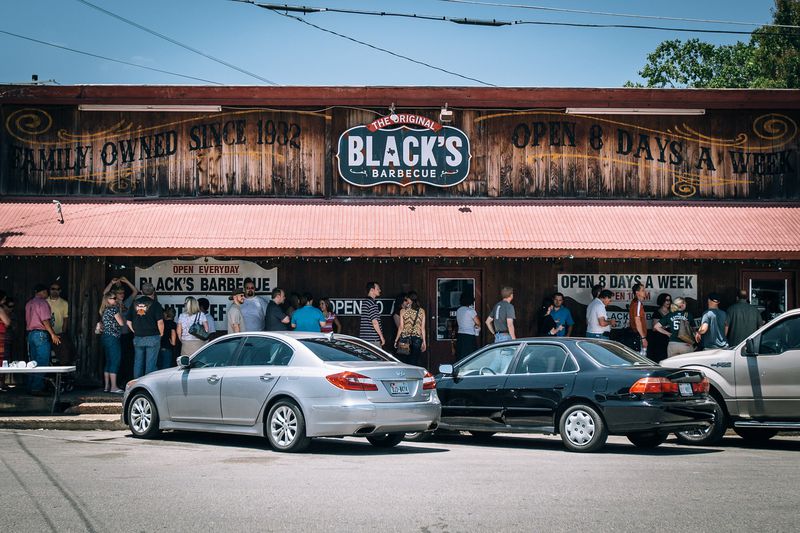 down in
the “Official
Barbecue Capital of Texas.”
There's not much to see en route; the
landscape is fertile but depressingly flat, and
about the only thing to get excited about is the
big barn-looking Kreuz Market that looms on your
right as you enter the town. The other thing to
get excited about are its two competitors, Black's and
Smitty's Market,
each located at opposite ends of the quaint town
square.
down in
the “Official
Barbecue Capital of Texas.”
There's not much to see en route; the
landscape is fertile but depressingly flat, and
about the only thing to get excited about is the
big barn-looking Kreuz Market that looms on your
right as you enter the town. The other thing to
get excited about are its two competitors, Black's and
Smitty's Market,
each located at opposite ends of the quaint town
square.
The smokehouses around Lockhart
began in the mid-19th century as German butcher
shops opened by immigrants who settled in the
area. Sausage making is a natural by-product of
cattle and pig slaughtering—and the best way to
sell all the tidbits left on the chopping
block—and smoking these leftovers was the fastest
way to preserve the meat in the days before
refrigeration. The proximity of these three icons
of smoked meat to each other—you can walk between
Smitty's and Black's, and Kreuz is a two-minute
drive from either of them—makes for quite the 'cue
consumption conundrum. Where do we start? How much
do we eat? What if we love one so much we don't
want to leave?
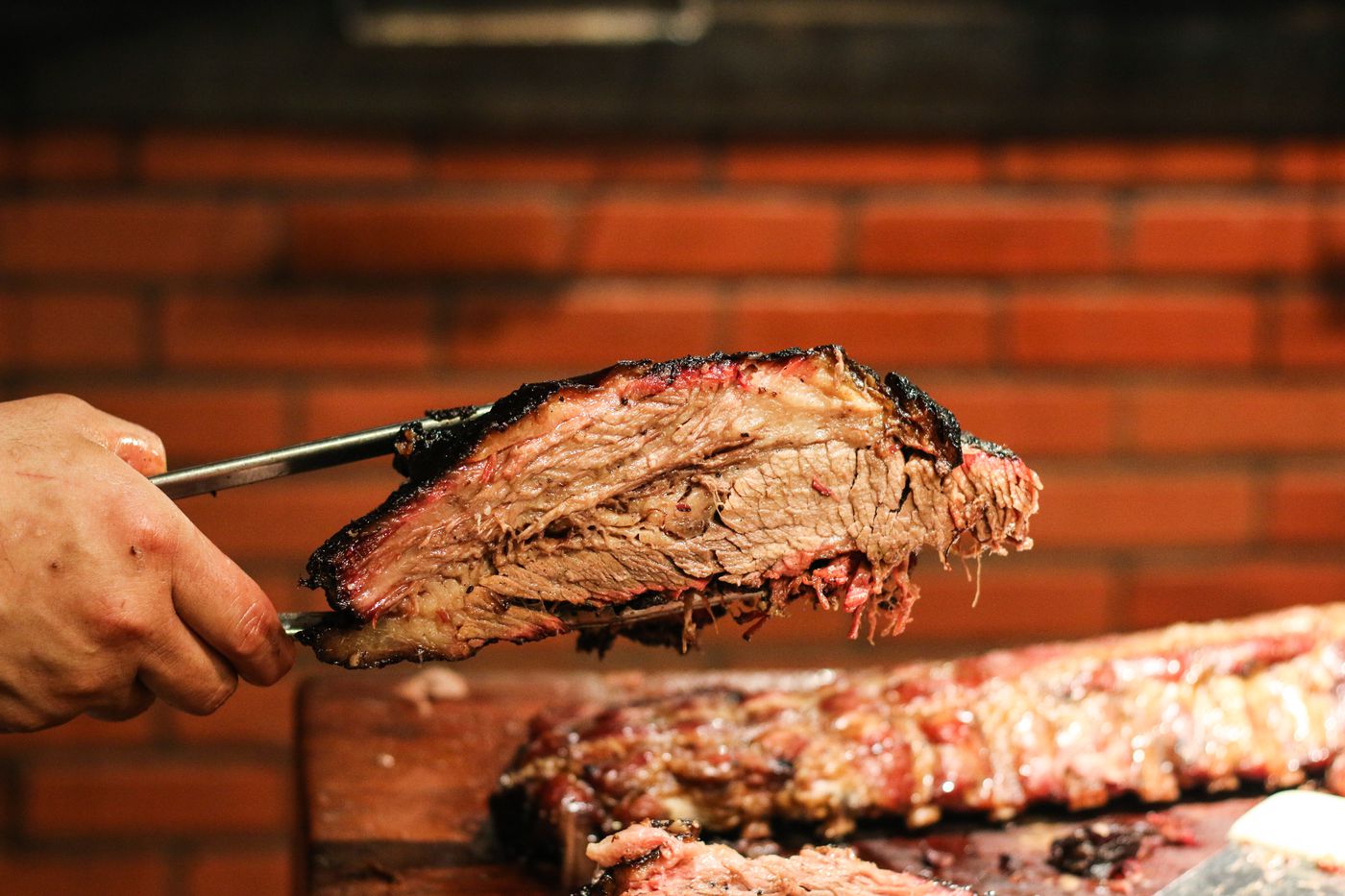 These questions went out
the window as soon as we saw the sign that said "Giant Beef Ribs" at Black's. These
were huge: 24
ounces of spoon-tender, juicy, smoky beef with a
bark so sweet, black and peppery it could be sold
as meat candy (left).
Black's is more conventional than its two
neighbors, and ordering is done on a cafeteria
line that leads you to the meat station, where you
choose how much, per pound or slice, you want of
the meat. Instead of the butcher paper that most
joints use, here you get real plastic plates and
utensils. It may not be as authentically "old
school" in appearance as Smitty's, but that beef
rib is worth a special trip all by itself.
These questions went out
the window as soon as we saw the sign that said "Giant Beef Ribs" at Black's. These
were huge: 24
ounces of spoon-tender, juicy, smoky beef with a
bark so sweet, black and peppery it could be sold
as meat candy (left).
Black's is more conventional than its two
neighbors, and ordering is done on a cafeteria
line that leads you to the meat station, where you
choose how much, per pound or slice, you want of
the meat. Instead of the butcher paper that most
joints use, here you get real plastic plates and
utensils. It may not be as authentically "old
school" in appearance as Smitty's, but that beef
rib is worth a special trip all by itself.
Black’s sausage was stellar as
well. These fresh-made farm sausages are a
sub-specialty of Texas barbecue unto themselves.
Minimally seasoned and loosely packed (sometimes
very loosely packed), they’re not the fine, dense
sausages you find in central Europe, where long
curing and various spicing develops an entirely different product.
We were also nuts about
Black’s mac-n-cheese and its enormous dill pickle, although
in the interest of limiting our consumption we
left most of them barely touched on the plate.
About the only thing we found lacking was the
sauce—slightly thin, standard issue stuff—but the
meats, including the brisket, were so amazing we
quickly forgot about it.
It’s the antiquated, authentic
details that separate Texas barbecue from other
pretenders. All of your meat is sliced to order,
and every person taking your order lets you be as
particular as you want, whether you want fatty
brisket or lean or a combo or a thin slice of this
or a thick helping of that. Nothing looks or
tastes like it's been sitting around in a steamer
tray for hours (because it hasn't), and the
intensity of the meat, smoke, bark and seasonings
is front and center with every bite.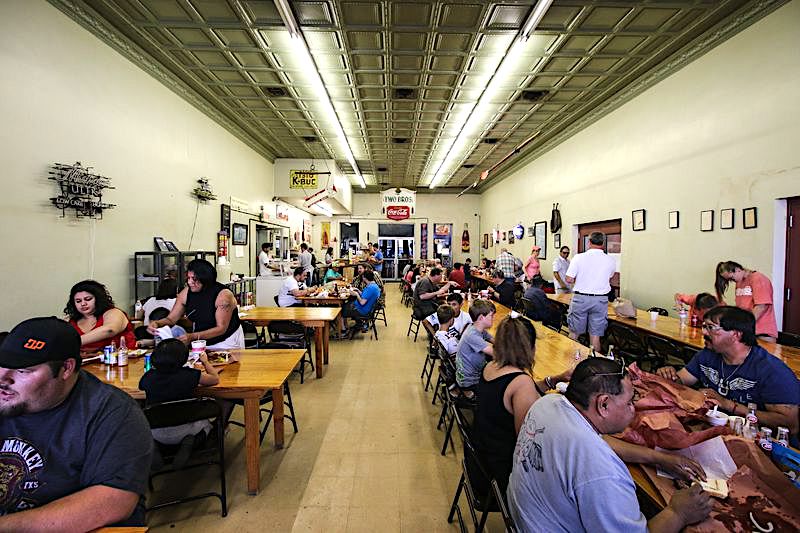
Something
else
front and center are the pits themselves. At Smitty's
(right),
and Kreuz, they are in the room where you do your
ordering. Smitty’s is literally a trip back in
time. It's housed in a structure built in 1924,
untouched by modernity, dripping with
authenticity, and covered in a layer of fatty soot
that's been a century in the making. You walk down
a long hallway lined with benches where the
trenchermen of years past would sit eating their
lunches of smoked meat, taken right from the
butcher shop on paper, and sliced and stabbed with
knives hanging on chains from 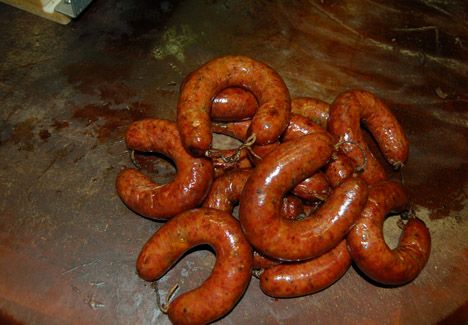 the walls. These days,
things are slightly more modern (there's a dining
room to chow down in that's straight from the
1940's, replete with wobbly benches and an
old-fashioned soda fountain), but you still go
into the smoke room to order your meat sliced, and
good luck finding a fork.
the walls. These days,
things are slightly more modern (there's a dining
room to chow down in that's straight from the
1940's, replete with wobbly benches and an
old-fashioned soda fountain), but you still go
into the smoke room to order your meat sliced, and
good luck finding a fork.
Unfortunately, Smitty’s brisket
didn't hold a candle to Black's. The former’s is
on the dry side and without the seasoning or smoke
of its rival. What saved Smitty's for us was the
vibe and the beautiful sausages (left), loaded
with black pepper, steaming with fat and the snap; they
were a beef/pork blend of uncommon toothsomeness,
and, my favorite "hot
guts" of the trip.
Finally, on the heels of those great meals,
there was Kreuz Market (below). It's
as big as a barn (actually several barns), and
seats hundreds in its several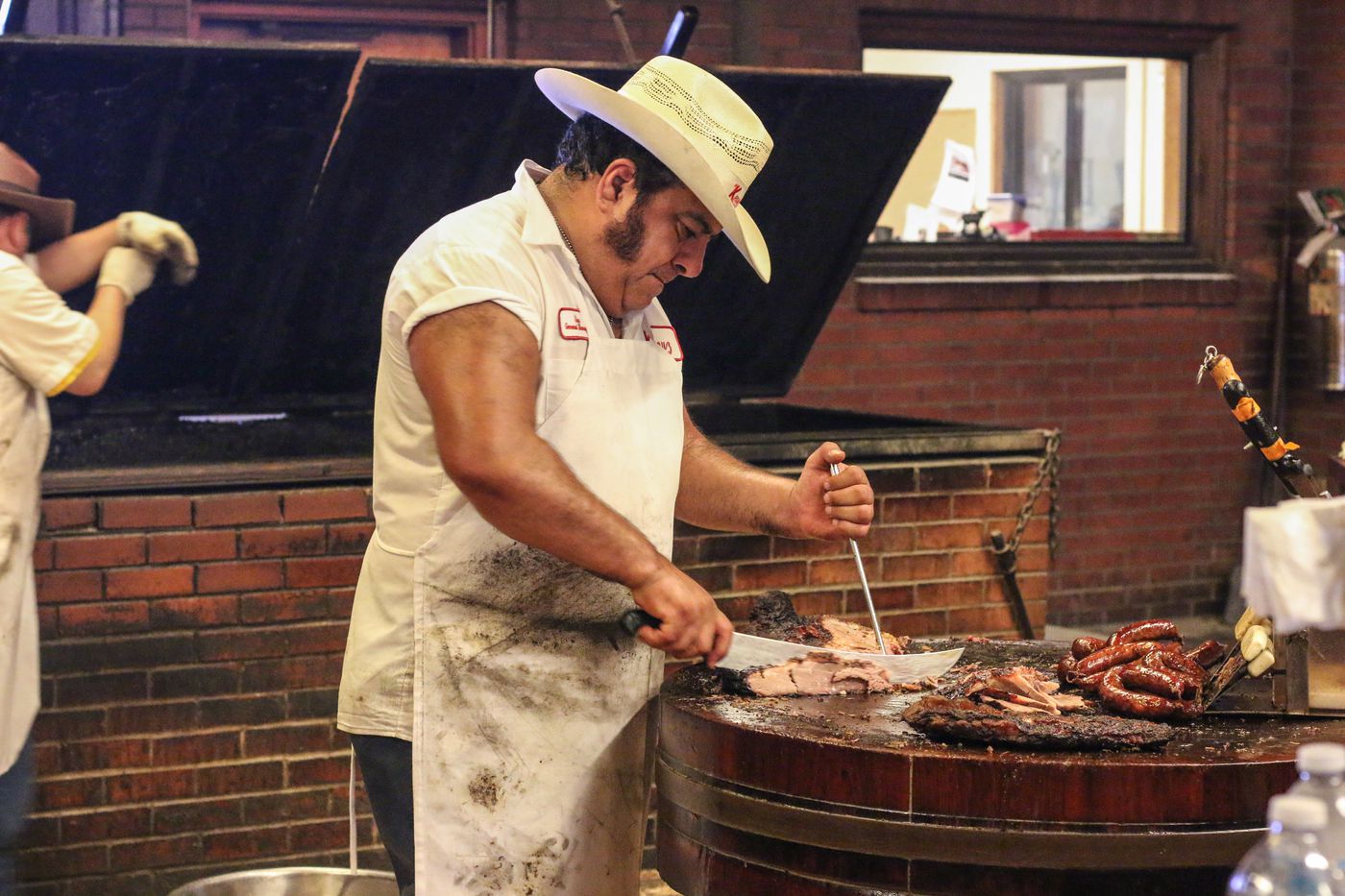 dining rooms. You do
the same order-in-the-smoke-room thing here, but
then you repair to one of its massive feed halls
to eat. What shows up on the plate would, no
doubt, be the best damn barbecue in 44 States.
Unfortunately, in Texas, the competition is pretty
stiff, and Kreuz’s stringy, tepid brisket didn't
meet the challenge. Kreuz (pronounced “Krites”) is famous for stubbornly
maintaining since 1900 that its brisket is so
good it needs no sauce. It needs sauce. On the
plus side, the smoked prime rib was ethereally
good, attaining an almost cured-ham-like texture
while maintaining its beefy integrity, and the
sausages were the stuff smoked sausage dreams
are made of.
Kreuz has been world famous for over half
a century and does a bang-up mail-order business
that moves mountains of meat, but we expected
the proclaimed godfather of Texas barbecue’s
brisket to knock us out of the saddle and it
didn't.
dining rooms. You do
the same order-in-the-smoke-room thing here, but
then you repair to one of its massive feed halls
to eat. What shows up on the plate would, no
doubt, be the best damn barbecue in 44 States.
Unfortunately, in Texas, the competition is pretty
stiff, and Kreuz’s stringy, tepid brisket didn't
meet the challenge. Kreuz (pronounced “Krites”) is famous for stubbornly
maintaining since 1900 that its brisket is so
good it needs no sauce. It needs sauce. On the
plus side, the smoked prime rib was ethereally
good, attaining an almost cured-ham-like texture
while maintaining its beefy integrity, and the
sausages were the stuff smoked sausage dreams
are made of.
Kreuz has been world famous for over half
a century and does a bang-up mail-order business
that moves mountains of meat, but we expected
the proclaimed godfather of Texas barbecue’s
brisket to knock us out of the saddle and it
didn't.
Undaunted, we were up
and at ‘em the first thing the next morning, for
an hour-long drive into the Texas hinterlands, in
search of the best barbecue breakfast on earth.
❖❖❖
FLAMBOYANT FAN OF LA NOUVELLE CUISINE
CHRISTIAN MILLAU DIES AT 88
By John Mariani
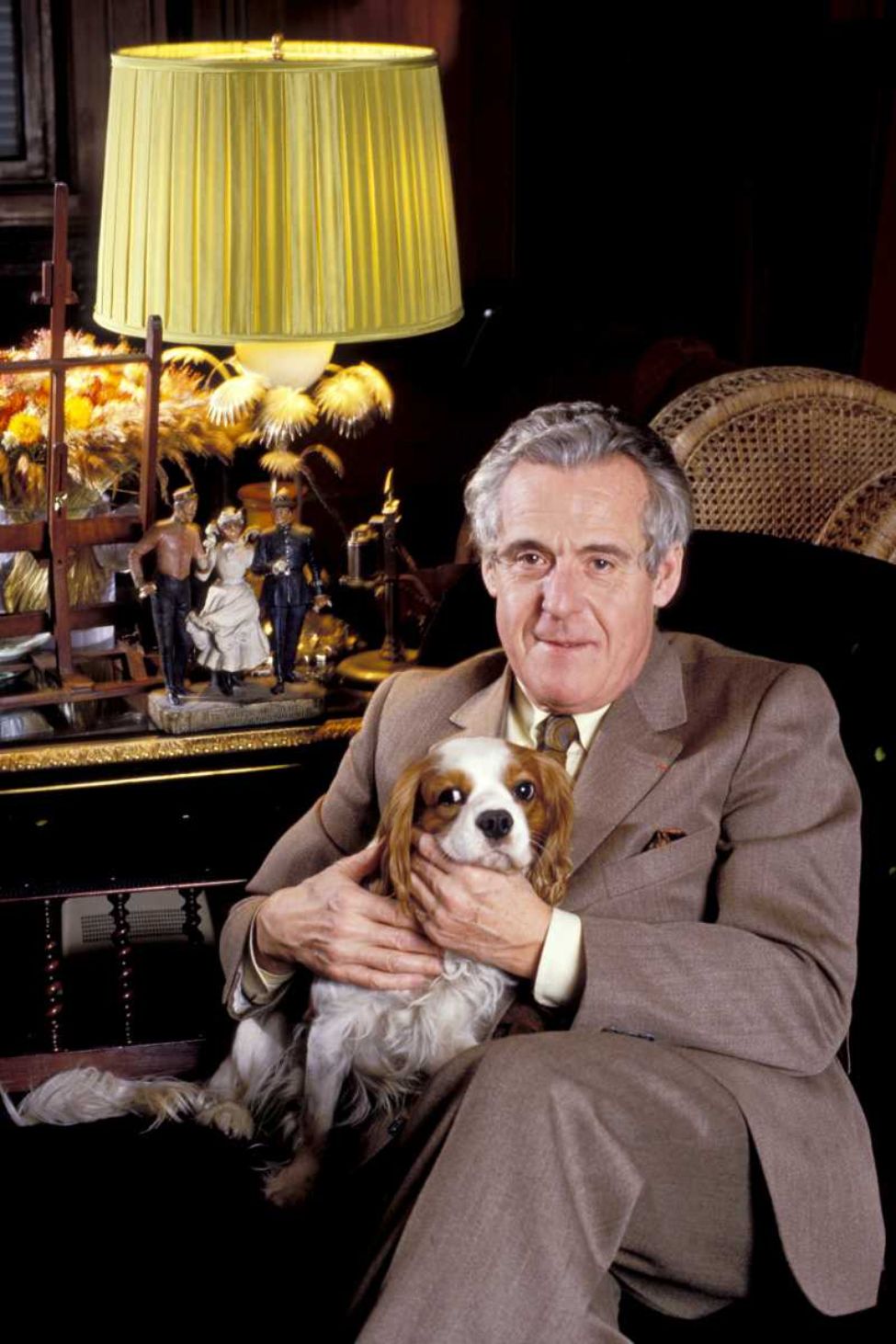 Christian
Millau might actually have preferred to be
remembered as the erudite author of award-winning
books like Galloping
with the Hussars: In the Literary Whirlwind of
the Fifties, but instead he will always be
the man who championed la nouvelle
cuisine in its infancy back in the 1960s. Millau died
last week in Paris at the age of 88.
Christian
Millau might actually have preferred to be
remembered as the erudite author of award-winning
books like Galloping
with the Hussars: In the Literary Whirlwind of
the Fifties, but instead he will always be
the man who championed la nouvelle
cuisine in its infancy back in the 1960s. Millau died
last week in Paris at the age of 88.
Along with his partner, Henri
Gault, Millau published an irreverent alternative
to the stultified Michelin
red guides under their names as well as a magazine
called Le
Nouveau Guide Gault-Millau, which was
awaited at French newsstands as much as Paris Match
and L’Officiel.
Millau was the
flamboyant one, the front man, Gault the shy
business manager of enterprises that poked large
holes in the moribund style of so many old line
French restaurants while encouraging young
chefs—young back then—like
Paul Bocuse (below),
Roger Vergé, Michel Blanc, Michel Guérard and
others to follow the “Ten Commandments of La
Nouvelle Cuisine,” which included: Avoid
unnecessary complications; shorten cooking times;
return to regional cooking; investigate the newest
techniques; consider diet and health; and invent
constantly.
Unfortunately, media
concentrated on the last two as the signal
constructs of the movement, ignoring the perfectly
commonsensical suggestions that preceded them. Gault
and Millau never railed against classic French
cuisine, and the idea that modern cuisine be so
light as to qualify as diet food was completely
blown out of proportion. Indeed, only Michel Guérard
offered a cuisine
minceur (“slimming” cuisine) at his
restaurant, but it was in addition to his regular
menu that was full of butter, cream, foie gras and
caviar.
I met Millau a few times, both
in New York and Paris, and he hired me as a
contributor to the Gault-Millau
Guides to
NYC and Boston. He was
truly a bon vivant but never an idle flaneur, for
he was an extremely well-educated man whose
interests went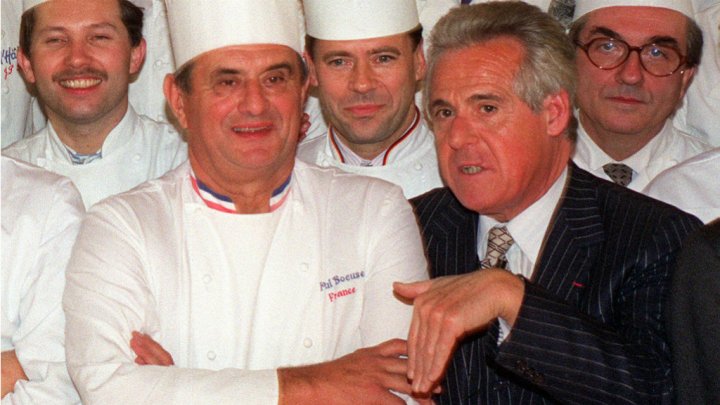 far
beyond the gastronomic. He hated pretension, raged
against high prices, and got behind regional wines
that cost far less than the classified crus of
Bordeaux and Burgundy. He loved California, even
did a guide to Dallas, and was amused by how
serious the American food media took their
subject. He
found absurd the idea that a critic needed to go
to a restaurant three, four, five times before
making a decision to give a star rating.
Gault-Millau never copied Michelin’s stars; it
gave out chef’s toques as symbols and rated on a
scale of 1 to 20.
No restaurant ever received 20 points
because, he said, no restaurant is perfect.
far
beyond the gastronomic. He hated pretension, raged
against high prices, and got behind regional wines
that cost far less than the classified crus of
Bordeaux and Burgundy. He loved California, even
did a guide to Dallas, and was amused by how
serious the American food media took their
subject. He
found absurd the idea that a critic needed to go
to a restaurant three, four, five times before
making a decision to give a star rating.
Gault-Millau never copied Michelin’s stars; it
gave out chef’s toques as symbols and rated on a
scale of 1 to 20.
No restaurant ever received 20 points
because, he said, no restaurant is perfect.
I learned a lot just dining
with Christian, not least to enjoy oneself at the
table as much as possible rather than whisper into
hidden recorders, write notes under the table and
steal menus out of sight of the captain. I also
learned from him that food and wine are a
complement to the good life, but not everything;
but if you could make a good living writing about
them, so much the better.
After enjoying such a long
life, Millau reminds me of the man whose doctor
told him, “If you keep eating and drinking like
this you are going to die a slow death,” to which
the man replied, “I’m in no hurry.”
❖❖❖
By John Mariani
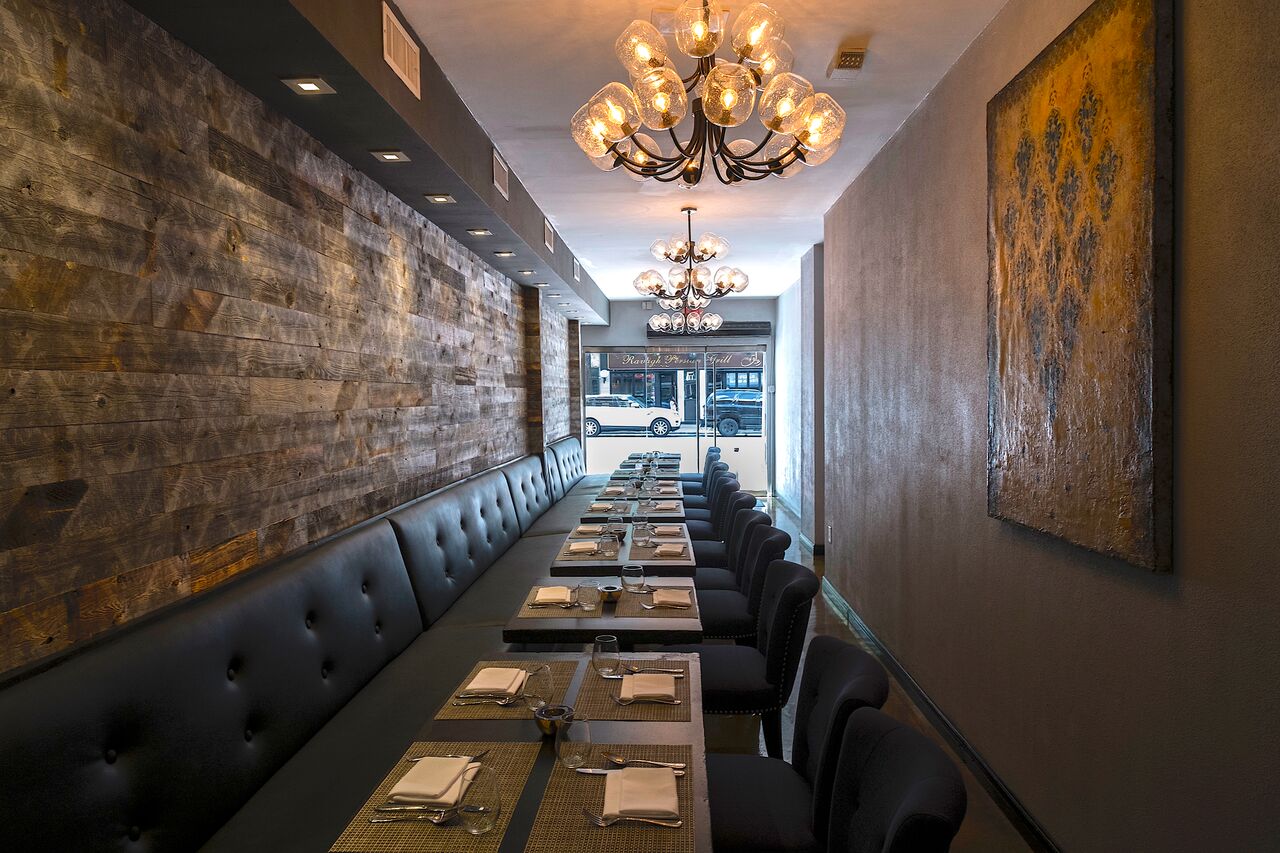 IMLI
IMLI
1136 First Avenue (near 63rd
Street)
212-256-0073
Just two months old,
Imli is focusing on the small plates traditions
of regional India and the results are exciting.
Owners Mervyn Winston, Ram Reddy and Albin
Vincent, along with Chef Manuel Butler, are
channeling the all-day cafés of Mumbai, but
doing so in one of the most stylish interiors on
this restaurant-rich stretch of First Avenue.
There are two doorways, one to
the bar area, beyond which is a patio for summer
dining, an open kitchen and a long dining room
with one wall stenciled panels of sanded old barn
wood and the opposite wall a shimmering coating of
gray. Open-bulb
chandeliers cast a pretty light, the floor is a
rust-colored lacquer and the tables are made of
black concrete.
No bronze figurines or posters of the Taj
Mahal adorn the place. The only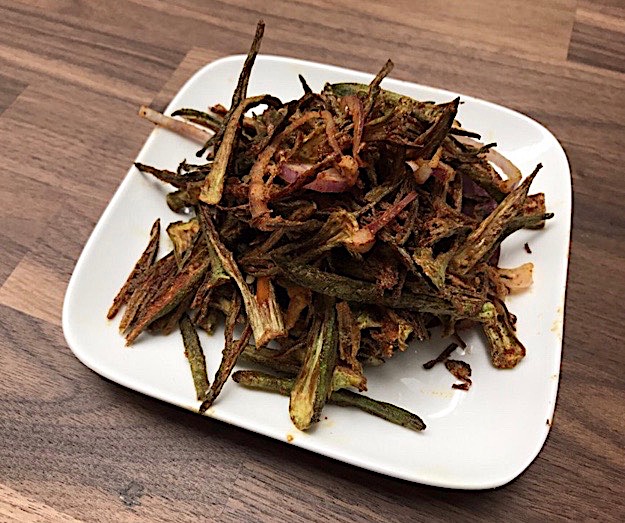 odd
intrusion is a Spotify mix of disco and other
techno music.
odd
intrusion is a Spotify mix of disco and other
techno music.
Chef Butler has consulted or
worked for a number of notable NYC Indian
restaurants, including Sahib, Dhaba, Awadh,
and Chote Nawab. At Imli (which means tamarind)
the most enticing items are what he calls “Indian
tapas”; main courses not so much. (Brunch
is inspired by the cuisine of the Parsi
population, who fled from Persia in the 8th and
10th centuries to established successful
communities in India.)
Once you are seated, the waiter
brings you a selection of six different condiments
for use throughout the meal—coriander, yogurt,
pear-apple, tamarind, mustard, and more—some mild,
some hot. Then you’re handed a multi-page menu
that can boggle the receptive mind. I just
asked Reddy to ask the chef to send out anything
he wished until we screamed “uncle!”
The array was really amazing in
that most dishes differed from any I’ve had in
Indian restaurants around town. All are
prettily presented on various plates and you won’t
need any Indian breads until later in the meal.
When I mark up the menus obtained from a
restaurant, I put little asterisks next to the
dishes I liked most, and my Imli menu is full of
stars for tapas items ($5-$12) like achari
mushrooms seasoned with garam masala
and a Southern Indian spice blend; crispy okra
shredded like zucchini and deep-fried (above), 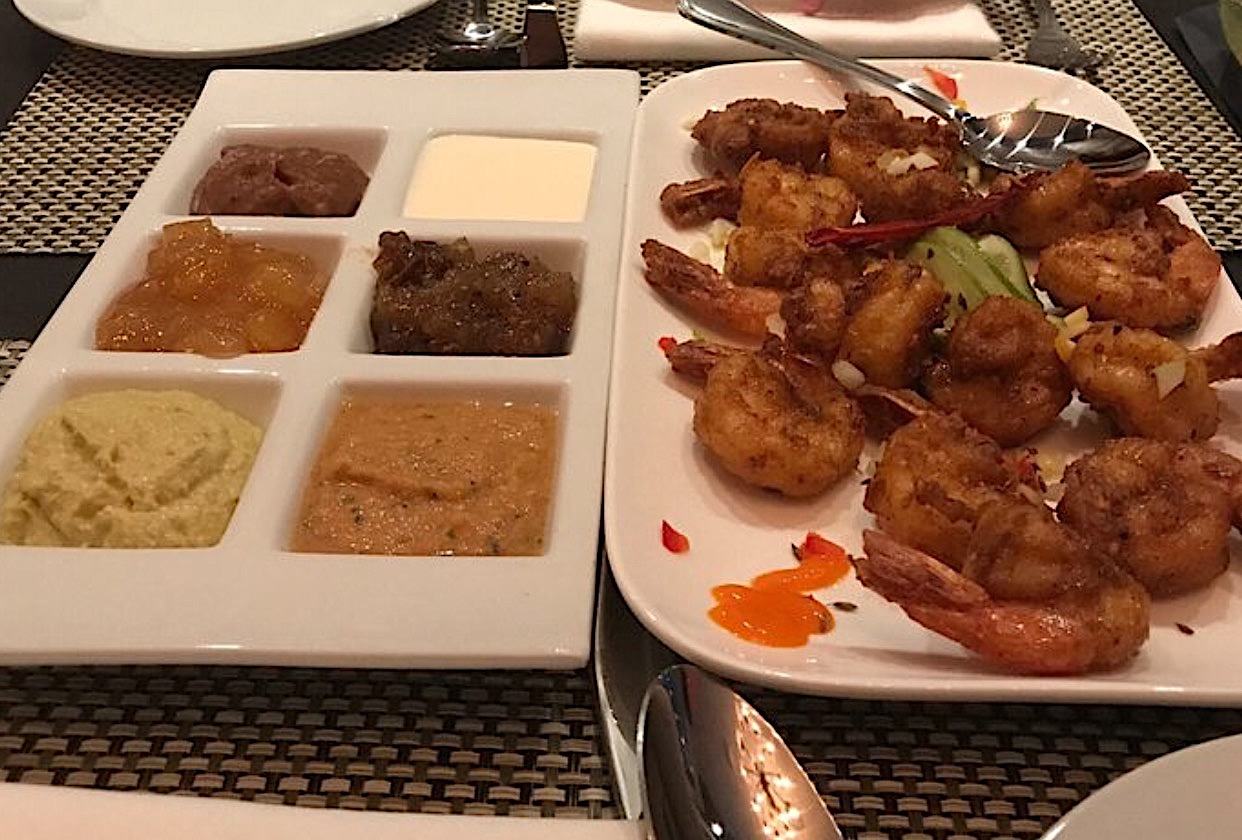 a welcome alternative to the slimy
texture of many okra dishes; Kerala beef marinated
in yogurt with onions, pepper and cardamom;
chicken chaat,
a classic Mumbai street food; and shrimp Koliwada
(left),
battered with spices and fried, with chili and
peppers. Also delicious was
cauliflower tikki,
and from the tandoor oven, basil-scented chicken
morsels ($15) and saffron-dusted chicken tikka ($15).
a welcome alternative to the slimy
texture of many okra dishes; Kerala beef marinated
in yogurt with onions, pepper and cardamom;
chicken chaat,
a classic Mumbai street food; and shrimp Koliwada
(left),
battered with spices and fried, with chili and
peppers. Also delicious was
cauliflower tikki,
and from the tandoor oven, basil-scented chicken
morsels ($15) and saffron-dusted chicken tikka ($15).
There are dozens more of
these small plates and I highly recommend you and
your party make an entire meal of them, because
the main courses ($16-$23), while good, do not
much differ from similar ones you’ll have around
town. Chicken
curry with ginger, fennel and coriander seeds was
good, but lamb rogan josh’s meat was overcooked, as
was a beef curry. Duck is an unusual dish and it’s
actually cooked closer to a French style—very,
very rare breast—than you’d otherwise find in
India.
As for the Indian breads, they
are some of lightest and flakiest I’ve had in NYC,
the texture perfect, one with garlic that was 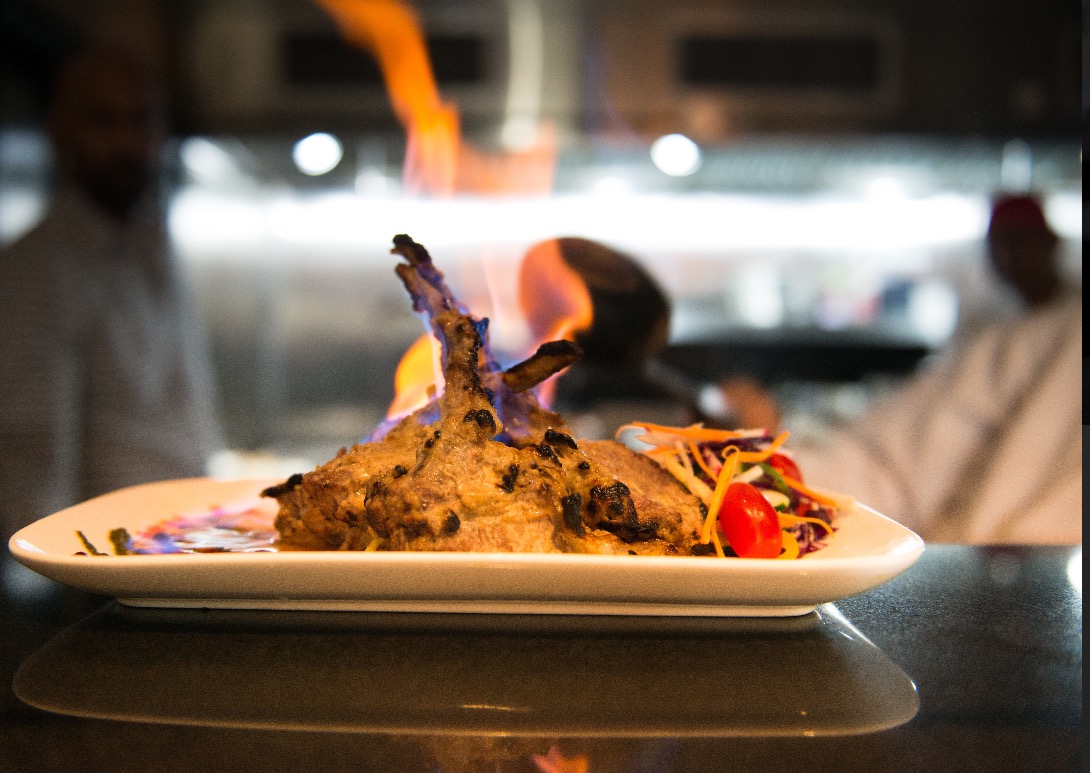 nicely subtle.
nicely subtle.
The wait staff will ask you
what your desire is for the level of heat and
spice in your food, and, out of one to five (the
hottest), ours measured about a three, which
brings out more levels of flavor. I might
request in the future some of the dishes be made
hotter.
Except for an odd crème brûlée
with kulab
jamun dumpling plopped on top, the desserts
like ras
malai and rice pudding are fairly standard
at Imli.
Indian beer goes well with this
food, but the management has put a lot of effort
into choosing wines that marry with the spices,
none marked up very high. There
is also the requisite cocktail list containing
some Far Eastern spices and herbs.
So, if you think that so
often the first courses in a restaurant, be it
Indian or French, Italian or Japanese, are the
most interesting, you’ll be very happy at Imli,
where it would take several visits to cover just
the tapas alone.
No need to hurry. Prices are very fair and
portions good. If I lived in the area, I’d be
there once a week.
Imli is open for lunch Mon.-Fri.; brunch Sat. & Sun.; dinner nightly.
❖❖❖
WHAT I'M DRINKING NOW

By John Mariani
Louis
Pommery
California Brut Sparkling Wine ($24)—This
is actually the first California sparkling wine
created by Champagne Pommery—just released—which
is careful not to call it Champagne. Made of
96% Chardonnay and 4% Pinot Noir, it is in the
vivacious style of Pommery, with good
effervescence, and at $24 a terrific sparkler
indeed. Taking
advantage of the warm sun—which France’s Champagne
region wishes it had more of—boosts the fruit,
including a lemony acidic freshness that buoys the
peach flavor.
An excellent party wine, if your parties
have a sophisticated guest list.
 Casillero del Diablo
Chardonnay Reserva 2014 ($8)—This Chilean
estate is among the vast holdings of Concha y Toro
and is located near the cooling breezes of the
Pacific Ocean in the Limari Valley. The
minerals in the soil do well by this remarkable
Chardonnay, easily as fine as others three or four
times the price. It spends time both in French oak
and stainless steel tanks and shows very pleasing
acidity alongside good tropical fruit. A real
bargain in every way.
Casillero del Diablo
Chardonnay Reserva 2014 ($8)—This Chilean
estate is among the vast holdings of Concha y Toro
and is located near the cooling breezes of the
Pacific Ocean in the Limari Valley. The
minerals in the soil do well by this remarkable
Chardonnay, easily as fine as others three or four
times the price. It spends time both in French oak
and stainless steel tanks and shows very pleasing
acidity alongside good tropical fruit. A real
bargain in every way.
RoseRock
Chardonnay 2015 ($27)—French vigneron
Joseph Drouhin has been making wine in Oregon
since 1987 and led the way for the scores on
Americans to follow the company into the
Willamette Valley.
This Chardonnay is made in the high
elevation of the Eola-Amity Hills, cooled by the
temperatures within the Van Duzer corridor. The
vintage of 2015 was an exceptional year
weather-wise, and this wine came from three blocks
as each found its own ripeness. It is the
antithesis of over-oaked, sweet West Coast
Chardonnays and more in the subtler Burgundian
style.
Symmetry
Meritage 2013 ($40)—I’m a big fan of what
Rodney Strong produces at reasonable prices and
this, one of his finest, has all the bright fruit
you expect from a Bordeaux-style blend of 76%
Cabernet Sauvignon, 8% Petit Verdot, 8% Cabernet
Franc, 4% Malbec and 4% Merlot. Sixteen
months in French oak has mellowed its tannins and
now, four years old, it is ready to enjoy but will
last a long while into the next decade.
Pio
Cesare Barbaresco Bricco di Treiso 2013
($129)—Pio Cesare has a history in Piedmont that
stretches back 135 years, and today their
Barbaresco takes the best of the traditional
methods of making this long-lived wine and new
techniques that keep it fresh and fruited.
Winemaker Paolo Fenocchio, here since 1981, knows
every inch of soil on three plots of land from the
family property, Family Vineyard Cascina Il
Bricco, in the village of Treiso. Made
from 100% Nebbiolo grapes, the wine is vinified at
unusually high temperatures in steel tanks, with
skin contact maceration for 25 days, and 30 months
in oak, which gives both complexity and real
character to the wine, taming the tannins along
the way.
 Vietti
Nebbiolo Perbacco 2014 ($20)—This
Piedmont
wine from the Langhe is a lighter, less complex
bottling than Barolo or Barbaresco, both made from
the same grape (some wine from Vietti’s same
vineyards actually goes into their Barolo
Castiglione), and for that it is well worth
drinking sooner rather than later. The 2014 is
just fine right now, with a sensible alcohol
level, 13.8%.
It’s certainly not lightweight but not
heavy in texture either, making it ideal for game
birds this fall.
Vietti
Nebbiolo Perbacco 2014 ($20)—This
Piedmont
wine from the Langhe is a lighter, less complex
bottling than Barolo or Barbaresco, both made from
the same grape (some wine from Vietti’s same
vineyards actually goes into their Barolo
Castiglione), and for that it is well worth
drinking sooner rather than later. The 2014 is
just fine right now, with a sensible alcohol
level, 13.8%.
It’s certainly not lightweight but not
heavy in texture either, making it ideal for game
birds this fall.
Castello
Banfi
Brunello di Montalcino 2012
($80)—Castello Banfi was not just instrumental in
revolutionizing the staid vineyards around
Brunello but shared all the knowledge Banfi
acquired and shared it with their competitors in
Tuscany. This
is their flagship Brunello of 100% Sangiovese,
which depends on careful grape selection followed
by vinification in temperature-controlled hybrid
stainless steel and wood tanks, with skin
contact for 10-12 days, then ages for two years in
various sizes oak barrels, then for another 8-12
months in bottle before release. The result is a
wine that has mellowed and begun to reveal its
special qualities of balance and finesse, though
it will go on for decades.
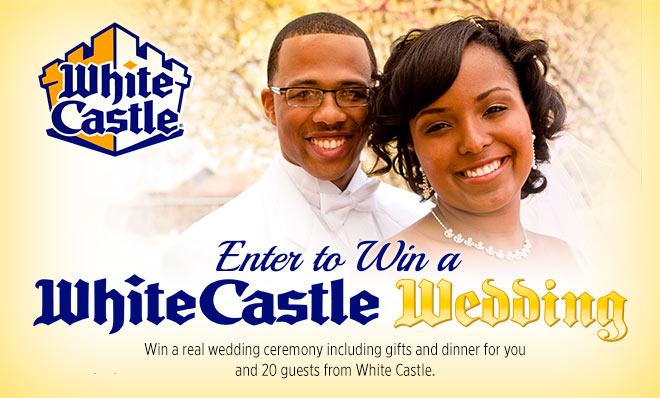
WE CAN ONLY IMAGINE WHAT THE
LOVELY PARTING GIFTS WILL BE

CLICHÉ POSSIBLE IN THE FIRST SENTENCE.
“Everything
is bigger in Texas.”
-- “A Comprehensive Guide to Road Tripping to Texas,"--Eater.com
(6/17).
"Los Angeles is a huge city."--Eater.com
(9/17).
Sponsored
by Banfi Vintners
SUMMER IS STILL HERE
AND SO ARE WONDERFUL CHILEAN WINES
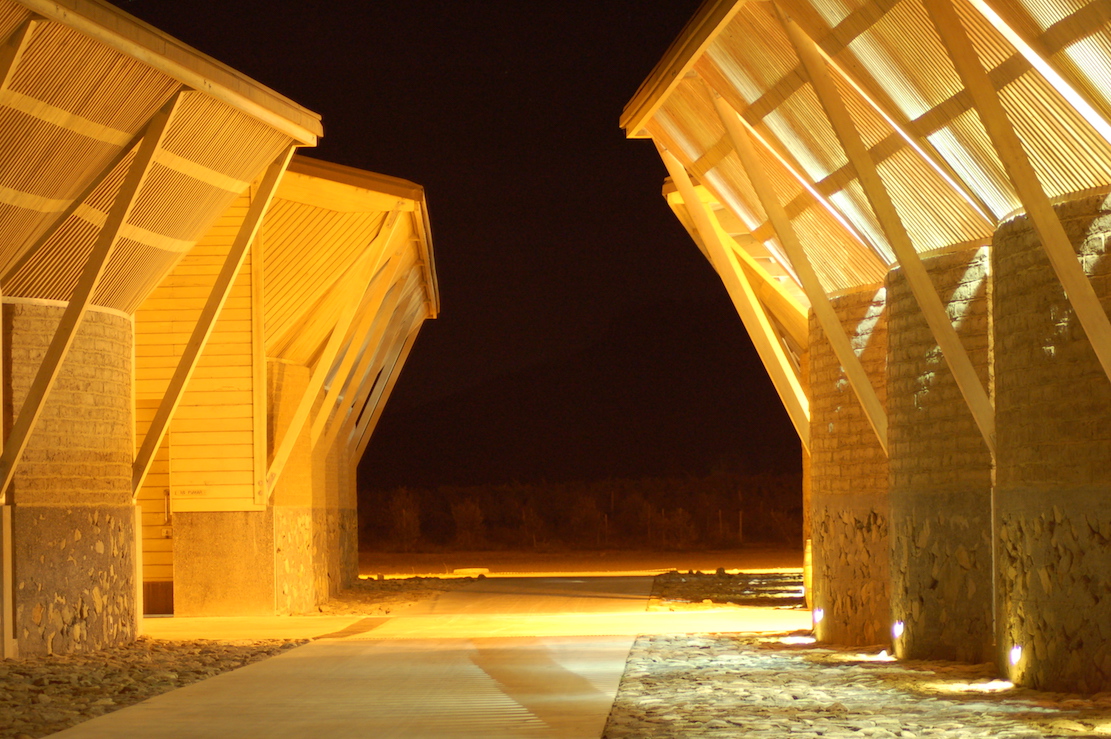 As
Summer winds its way to autumn, we are reminded of the
fragility of Mother Earth and her bounty. As an
importer representing several family wine makers from
around the globe, I often like to point out that all
the wines that we represent are green, some of them
greener than others. The greenest of all are
classified as Biodynamic or certified Organic.
One of the most interesting selections of
eco-balanced, organic and biodynamic wines comes to us
from Chile and the vineyards of Emiliana.
As
Summer winds its way to autumn, we are reminded of the
fragility of Mother Earth and her bounty. As an
importer representing several family wine makers from
around the globe, I often like to point out that all
the wines that we represent are green, some of them
greener than others. The greenest of all are
classified as Biodynamic or certified Organic.
One of the most interesting selections of
eco-balanced, organic and biodynamic wines comes to us
from Chile and the vineyards of Emiliana.
Emiliana was founded by our
friends, the Guilisasti family, who have a long and
proud history of winemaking with their Concha y Toro
brand. Three decades ago, well ahead of the
curve that has made organic wines all the rage today,
they set up dedicated and, most important for organic
farming, isolated vineyards for this type of
agriculture. Many may picture the small farmer
as being the most “organic,” but in the reality of our
wine world, sometimes it takes the “big guys” to act
as a locomotive to get a movement such as this on
track.
Organic farming is a form of
agriculture which avoids or largely excludes the use
of synthetic fertilizers and pesticides, plant growth
regulators, and livestock feed additives.
Organic farmers rely on crop rotation, crop residues,
animal manures--including llamas (below)--and
mechanical cultivation to maintain soils productivity
and health, to supply plant nutrients, and to control
weeds, insects and other pests. To call a wine
organic in the US, government regulation says that it
must be produced from 95% organically grown
ingredients with no added sulfites. If you add
sulfites in the relatively minimal amount of 100 parts
per million, you can only say that the wine is “made
from organically grown grapes.” Now, not to go
into a chemistry lesson, but it is virtually
impossible to make a wine without that modest dose of
sulfites, at least if you want to drink it beyond ten
feet of the cellar it was made in and wish it to
survive any moderate amount of aging.
Biodynamic farming adheres
to the same principles, but takes it one step further
by relying on the cycles of the moon and the sun to
dictate much of what is done in the field, and uses
animal treatments such as compost teas, horns buried
with fertilizer, deer bladders, etc., to
treat the soil. It may sound a little hocus
pocus, but in reality it is very comparable to
homeopathic medicine, using the body’s (in this case,
the earth’s) own energy to heal
itself.
Emiliana has four distinct
collections of lovingly crafted organic wine now
available in the US – the base line of Natura, the
next step up in Novas, a stand-alone wine in Coyam,
and the ne-plus-ultra of bio-dynamic wines, Ge.
One taste of any of these and you too may find
yourself turning green – not with envy, but for a
newfound love of organic winemaking!
Recommended – green
wines for Spring:
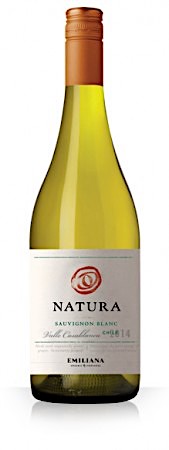 Natura
Chardonnay In the cool coastal Pacific climate of
the Casablanca Valley, organically grown grapes are
hand picked during the last week of March, and
vinified in stainless steel tanks, free of the
domineering influence of oak. On the nose,
tantalizing citrus aromas of grapefruit and lime blend
with notes of pineapple, all of which reappear on the
palate and finish with balance thanks to the wine’s
freshness and natural acidity. Delicious with
spring salads and seafood dishes.
Natura
Chardonnay In the cool coastal Pacific climate of
the Casablanca Valley, organically grown grapes are
hand picked during the last week of March, and
vinified in stainless steel tanks, free of the
domineering influence of oak. On the nose,
tantalizing citrus aromas of grapefruit and lime blend
with notes of pineapple, all of which reappear on the
palate and finish with balance thanks to the wine’s
freshness and natural acidity. Delicious with
spring salads and seafood dishes.
Natura Carmenere – From the rustic isolation of the
Colchagua Valley, this intense and voluptuous offers
aromas of cherries, chocolate and spice, coming
together in ramped up volume on the palate with soft,
round tannins and firm, well-balanced structure.
Great balance between fruit and oak, with a long,
juicy finish.
Novas Sauvignon Blanc Gran Reserva – Hailing from the San Antonio Valley’s
thin rocky and clay soils, the organic grapes for this
wine are harvested by hand in March and undergo
fermentation in stainless steel to preserve their
bright fruit character. Herbal notes mixed with
citrus and soft floral hints fill the bouquet; the
taste is medium bodied with grapefruit flavors joined
by a delicate acidity and a touch of minerality.
Novas Pinot Noir Gran Reserva – The grapes for this wine are grown in the
cool, coastal Casablanca Valley’s permeable sandy loam
soils, and harvested by hand. After a cold soak
on the skins, the wine is aged for 8 months in French
oak barrels to add character, depth and
roundness.
Bright ruby red in color with attractive
aromas of berries, strawberries and notes of spice and
cocoa, this wine bursts with fruit flavor, layered
with earthiness. Delicious with white meats, light
sauces, full flavored fish and shellfish, cured ham
and sushi.
Coyam – A blend dominated by Syrah with nearly
equal parts of Carmenere and Merlot balanced by
“soupcons” of Cabernet Sauvignon, Mourvedre and Petit
Verdot, from the Colchagua Valley estate called Los
Robles – Spanish for the oaks, called “Coyam” by
the native Mapuche people in their own language. Hand
harvested certified biodynamic grapes are naturally
fermented in French oak barrels. Coyam is
largely unfiltered and aged for 13 months in
barrels. Aromas of ripe red and black fruits
integrate with notes of spice, earth and a hint of
vanilla bean. Elegant expressions of fruit are
delicately interwoven with oak, mineral and toffee.
Ge – Chile’s first certified biodynamic wine,
the name Ge is a nod to Geos, the earthly environment
pulling together all the elements that surround
us. Ge is a blend of nearly equal parts of
Syrah, Carmenere and Cabernet Sauvignon grown in the
deep soils of colluvial origin in the coastal range,
which lends mineral complexity. Naturally fermented in
oak barrels, Ge is deep plum red with violet tones; it
offers intense aromas of black fruits and berries
alongside mineral notes and a soft touch of tobacco
leaf. Generously fruity with cedar notes, Ge is
well balanced with tremendous volume, well rounded
tannins and a long finish.
For more information please visit http://www.banfiwines.com/winery/emiliana/
Any of John Mariani's books below may be ordered from amazon.com.
 The
Hound in Heaven (21st Century Lion Books)
is a novella, and for anyone who loves dogs,
Christmas, romance, inspiration, even the supernatural, I
hope you'll find this to be a treasured favorite.
The story concerns how, after a New England teacher,
his wife and their two daughters adopt a stray puppy found
in their barn in northern Maine, their lives seem full of
promise. But when tragedy strikes, their wonderful dog
Lazarus and the spirit of Christmas are the only things
that may bring his master back from the edge of
despair.
The
Hound in Heaven (21st Century Lion Books)
is a novella, and for anyone who loves dogs,
Christmas, romance, inspiration, even the supernatural, I
hope you'll find this to be a treasured favorite.
The story concerns how, after a New England teacher,
his wife and their two daughters adopt a stray puppy found
in their barn in northern Maine, their lives seem full of
promise. But when tragedy strikes, their wonderful dog
Lazarus and the spirit of Christmas are the only things
that may bring his master back from the edge of
despair. WATCH THE VIDEO!
“What a huge surprise turn this story took! I was completely stunned! I truly enjoyed this book and its message.” – Actress Ali MacGraw
“He had me at Page One. The amount of heart, human insight, soul searching, and deft literary strength that John Mariani pours into this airtight novella is vertigo-inducing. Perhaps ‘wow’ would be the best comment.” – James Dalessandro, author of Bohemian Heart and 1906.
“John Mariani’s Hound in Heaven starts with a well-painted portrayal of an American family, along with the requisite dog. A surprise event flips the action of the novel and captures us for a voyage leading to a hopeful and heart-warming message. A page turning, one sitting read, it’s the perfect antidote for the winter and promotion of holiday celebration.” – Ann Pearlman, author of The Christmas Cookie Club and A Gift for my Sister.
“John Mariani’s concise, achingly beautiful novella pulls a literary rabbit out of a hat – a mash-up of the cosmic and the intimate, the tragic and the heart-warming – a Christmas tale for all ages, and all faiths. Read it to your children, read it to yourself… but read it. Early and often. Highly recommended.” – Jay Bonansinga, New York Times bestselling author of Pinkerton’s War, The Sinking of The Eastland, and The Walking Dead: The Road To Woodbury.
“Amazing things happen when you open your heart to an animal. The Hound in Heaven delivers a powerful story of healing that is forged in the spiritual relationship between a man and his best friend. The book brings a message of hope that can enrich our images of family, love, and loss.” – Dr. Barbara Royal, author of The Royal Treatment.
 |
The Encyclopedia of American Food and Drink by John F. Mariani (Bloomsbury USA, $35) Modesty forbids me to praise my own new book, but let me proudly say that it is an extensive revision of the 4th edition that appeared more than a decade ago, before locavores, molecular cuisine, modernist cuisine, the Food Network and so much more, now included. Word origins have been completely updated, as have per capita consumption and production stats. Most important, for the first time since publication in the 1980s, the book includes more than 100 biographies of Americans who have changed the way we cook, eat and drink -- from Fannie Farmer and Julia Child to Robert Mondavi and Thomas Keller. "This book is amazing! It has entries for everything from `abalone' to `zwieback,' plus more than 500 recipes for classic American dishes and drinks."--Devra First, The Boston Globe. "Much needed in any kitchen library."--Bon Appetit. |
"Eating Italian will never be the same after reading John Mariani's entertaining and savory gastronomical history of the cuisine of Italy and how it won over appetites worldwide. . . . This book is such a tasteful narrative that it will literally make you hungry for Italian food and arouse your appetite for gastronomical history."--Don Oldenburg, USA Today. "Italian
restaurants--some good, some glitzy--far
outnumber their French rivals. Many of
these establishments are zestfully described
in How Italian Food Conquered the World, an
entertaining and fact-filled chronicle by
food-and-wine correspondent John F.
Mariani."--Aram Bakshian Jr., Wall Street
Journal.
"Equal parts
history, sociology, gastronomy, and just
plain fun, How Italian Food Conquered the
World tells the captivating and delicious
story of the (let's face it) everybody's
favorite cuisine with clarity, verve and
more than one surprise."--Colman Andrews,
editorial director of The Daily
Meal.com. "A fantastic and fascinating
read, covering everything from the influence
of Venice's spice trade to the impact of
Italian immigrants in America and the
evolution of alta cucina. This book will
serve as a terrific resource to anyone
interested in the real story of Italian
food."--Mary Ann Esposito, host of PBS-TV's
Ciao
Italia. "John Mariani has written the
definitive history of how Italians won their
way into our hearts, minds, and
stomachs. It's a story of pleasure over
pomp and taste over technique."--Danny Meyer,
owner of NYC restaurants Union Square
Cafe, The Modern, and Maialino.
|
 |
 |
 |
 |
 |
 |
 |
 |
 Everett Potter's Travel Report:
Everett Potter's Travel Report: 
 Eating Las Vegas
JOHN CURTAS has been covering the Las Vegas
food and restaurant scene since 1995. He is
the co-author of EATING LAS VEGAS – The 50
Essential Restaurants (as well as
the author of the Eating Las Vegas web site: www.eatinglasvegas.
He can also be seen every Friday morning as
the “resident foodie” for Wake Up With the
Wagners on KSNV TV (NBC) Channel 3 in
Las Vegas.
Eating Las Vegas
JOHN CURTAS has been covering the Las Vegas
food and restaurant scene since 1995. He is
the co-author of EATING LAS VEGAS – The 50
Essential Restaurants (as well as
the author of the Eating Las Vegas web site: www.eatinglasvegas.
He can also be seen every Friday morning as
the “resident foodie” for Wake Up With the
Wagners on KSNV TV (NBC) Channel 3 in
Las Vegas.

MARIANI'S VIRTUAL GOURMET
NEWSLETTER is published weekly. Editor/Publisher: John
Mariani.
Editor: Walter Bagley. Contributing Writers: Christopher Mariani,
Robert Mariani, Misha Mariani, John A. Curtas, Geoff Kalish, Mort
Hochstein, and
Brian Freedman. Contributing Photographer: Galina
Dargery. Technical Advisor: Gerry McLoughlin.
To un-subscribe from this newsletter,click here.
© copyright John Mariani 2017

